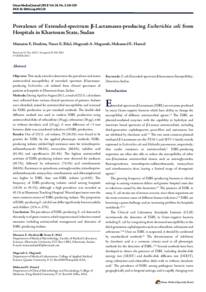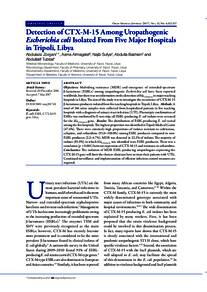Document
Prevalence of extended-spectrum β-lactamases-producing escherichia coli from hospitals in Khartoum State, Sudan.
Identifier
DOI 10. 5001/omj.2013.30
Contributors
Publisher
Oman Medical Specialty Board.
Gregorian
2013-03
Language
English
English abstract
Objective: This study aimed to determine the prevalence and assess antimicrobial susceptibility of extended- spectrum β-lactamase-producing Escherichia coli isolated from clinical specimens of patients at hospitals in Khartoum State, Sudan.
Methods: During April to August 2011, a total of 232 E. coli isolates were collected from various clinical specimens of patients. Isolates were identified, tested for antimicrobial susceptibility and screened for ESBL production as per standard methods. The double-disk diffusion method was used to confirm ESBL production using antimicrobial disks of ceftazidime (30 μg), cefotaxime (30 μg), with or without clavulanic acid (10 μg). A zone difference of >5 mm between disks was considered indicative of ESBL production.
Results: Out of 232 E. coli isolates, 70 (30.2%) were found to be positive for ESBL by the applied phenotypic methods. ESBL-producing isolates yielded high resistance rates for trimethoprim-sulfamethoxazole (98.6%), tetracycline (88.6%), nalidixic acid (81.4%) and ciprofloxacin (81.4%). The highest antimicrobial activities of ESBL-producing isolates were observed for amikacin (95.7%), followed by tobramicin (74.3%) and nitrofurantoin (68.6%). Resistance to quinolones, aminoglycosides, trimethoprim-sulfamethoxazole, tetracycline, nitrofurantoin and chloramphenicol was higher in ESBL than non-ESBL isolates (p<0.05). The frequency of ESBL-producing isolates varied among hospitals (18.2% to 45.1%), although a high prevalence was recorded as 45.1% at Khartoum Teaching Hospital. Wound specimens were the most common source of ESBL-producing isolates. The proportion of ESBL-producing E. coli did not differ significantly between adults and children (31% vs. 27%).
Conclusion: The prevalence of ESBL-producing E. coli detected in this study is of great concern, which requires sound infection control measures including antimicrobial management and detection of ESBL-producing isolates.
Member of
Resource URL
Citation
Ibrahim, Mutasim E., Bilal, Naser E., Magzoub, Magzoub A., & Hamid, Mohamed E. (2013). Prevalence of extended-spectrum β-lactamases-producing escherichia coli from hospitals in Khartoum State, Sudan. Oman Medical Journal, 28 (2), 116-120.
Category
Journal articles


